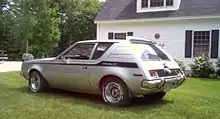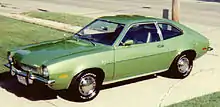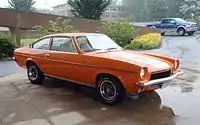Subcompact car
Subcompact car is an American classification for cars which is broadly equivalent to the B-segment (Europe) or supermini (Great Britain) classifications, and smaller than a compact car.

According to the U.S. Environmental Protection Agency (EPA) car size class definition, the subcompact category sits between minicompact and compact categories.[1] The EPA definition of a subcompact is a passenger car with a combined interior and cargo volume of between 85–99 cubic feet (2,410–2,800 L).[2] Current examples of subcompact cars are the Ford Fiesta and Chevrolet Sonic. The smaller cars in the A-segment / city car category (such as the Chevrolet Spark and Smart Fortwo) are sometimes called subcompacts in the U.S., because the EPA's name for this smaller category— minicompact— is not commonly used by the general public.[3]
The prevalence of small cars in the United States increased in the 1960s due to increased imports of cars from Europe and Japan. Widespread use of the term subcompact coincided with the early 1970s increase in subcompact cars built in the United States. Early 1970s subcompacts include the AMC Gremlin, Chevrolet Vega, and Ford Pinto.
History
1960s
The term subcompact originated during the 1960s.[1][4] However, it came into popular use in the early 1970s, as car manufacturers in the United States began to introduce smaller cars into their line-up.[5]
Previously, cars in this size were variously categorized, including "small cars" [6][7](p120) or "economy cars".
Several of these small cars were produced in the U.S. in limited volumes, including the 1930 American Austin (later called the American Bantam)[8] and the 1939 Crosley. From the 1950s onwards, various imported small cars were sold in the U.S., including the Nash Metropolitan, Volkswagen Beetle, and various small British cars. The term subcompact did not yet exist, so the Metropolitan was labeled a "compact or economy car" and marketed as a second vehicle for use around town, not as a primary car.[9][10] The Volkswagen Beetle was marketed with advertising pointing out the car's unconventional features as strengths and to get buyers to "think small."[11] Prompted by the British government for exports, Ford was one of the first companies to try and sell inexpensive small cars in volume. From 1948 to 1970, approximately 250,000 economical English Fords were imported to the US while over 235,000 went to Canada.[12] Models such as the 1960 Ford Anglia were promoted as "The world's most exciting light car."[13]
1970s
Due to the increasing popularity of small cars imported from Europe and Japan during the late 1960s, the American manufacturers began releasing competing locally-built models in the early 1970s.[14] The AMC Gremlin was described at its April 1970 introduction as "the first American-built import" and the first U.S. built subcompact car.[15][16][17] Also introduced in 1970 were the Chevrolet Vega and Ford Pinto.[18] Plans for the subcompact AMC Gremlin pre-dated Vega and Pinto by several years because of AMC's strategy to recognize emerging market opportunities ahead of the competition.[19]
Sales of American-built "low weight cars" (including subcompacts) accounted for more than 30% of total car sales in 1972 and 1973, despite inventory shortages for several models.[20] The Gremlin, Pinto and Vega were all rear-wheel drive and available with four-cylinder engines (the Pinto was also available with a V6 engine, and the Gremlin was also available with I6 and V8 engines).
The Pontiac Astre, the Canadian-originated re-badged Vega variant was released in the U.S. in September 1974.[21] Due to falling sales of the larger pony cars (such as the Chevrolet Camaro and first-generation Ford Mustang) in the mid-1970s, the Vega-based Chevrolet Monza was introduced as an upscale subcompact and the Ford Mustang II temporarily downsized from the pony car class to become a subcompact car for its second generation. The Monza with its GM variants Pontiac Sunbird, Buick Skyhawk, Oldsmobile Starfire, and the Mustang II continued until the end of the decade. The Chevrolet Chevette was GM's new entry-level subcompact introduced as a 1976 model. It was an 'Americanized' design from Opel, GM's German subsidiary. Additionally, subcompacts that were imported and marketed through domestic manufacturers' dealer networks as captive imports included the Renault Le Car and the Ford Fiesta
In 1977, the U.S. Environmental Protection Agency (EPA) began to use a new vehicle classification system, based on interior volume instead of exterior size.[22](p3) Sedans with up to 100 cubic feet of passenger luggage volume were classified as subcompact. There was not a separate subcompact station wagon class with all up to 130 cubic feet of volume classified as "small."
In 1978, Volkswagen began producing the "Rabbit" version of the Golf— a modern, front-wheel drive design— in Pennsylvania. In 1982, American Motors began manufacturing the U.S. Renault Alliance— a version of the Renault 9— in Wisconsin. Both models benefiting from European designs, development, and experience.[23]
1980s
To replace the aging Chevette in the second half of the 1980s, Chevrolet introduced marketed imported front-wheel drive subcompact cars: the Suzuki Cultus (a three-cylinder hatchback, badged as the Chevrolet Sprint) and the Isuzu Gemini (a four-cylinder hatchback/sedan badged as the Chevrolet Spectrum).
2000s to present
Because of consumer demand for fuel-efficient cars during the late-2000s, sales of subcompact cars made it the fastest growing market category in the U.S.[24] However, low gas prices and the added room in SUVs contributed to a 50 percent drop in sales of subcompacts in the first half of 2020 compared to 2019. [25] Most subcompacts were out of production by the end of the decade, including the Mazda 2 (discontinued after 2014), Scion xD (2016), Toyota Prius C (2017), Ford Fiesta (2019), Nissan Micra (2019), Smart Fortwo (2019), Fiat 500 (2019), Toyota Yaris (2020), Honda Fit (2020), and Chevrolet Sonic (2020).
Current subcompact cars in production as of 2021 include models such as the Chevrolet Spark, Hyundai Accent, Kia Rio, the Mitsubishi Mirage, the Nissan Versa, and the Mini Hatch.
See also
References
- "subcompact". merriam-webster.com. Retrieved 16 July 2017.
- "FAQ - How are vehicle size classes defined?". www.fueleconomy.gov. Retrieved 5 January 2012.
- Patton, Phil (9 September 2012). "Taking the 'Cheap' Out of the Small Car". The New York Times. Retrieved 10 September 2012.
- "The definition of subcompact". dictionary.com. Retrieved 31 December 2018.
- Shuldiner, Herbert (March 1972). "PS Tests Five Camping Trailers Can you match these little campers safely to your car?". Popular Science. 200 (3): 96.
The boom in subcompact cars is on.
- Foster, Patrick (2005-10-01). "Developing the Metropolitan". Hemmings Classic Car. Retrieved 2012-01-05.
During WWII and immediately afterwards, Mason began to explore the idea of developing a truly small car, the size of what today we'd call a subcompact.
- Popular Mechanics (November 1954 ed.). 1954. Retrieved 31 December 2018.
- U.S. Senate 93rd Congress (April 1974). "Second Session on S. 1167, Part 4: Ground Transportation Industries". Hearings Before the Subcommittee on Antitrustand Monopoly of the Committee on the Judiciary: 2480. Retrieved 19 January 2019.
- Lewis, Corey (22 March 2019). "Rare Rides: A Microscopic American Motors Metropolitan, From 1962". The Truth About Cars. Retrieved 30 December 2020.
- McGuire, Bill (22 October 2000). "1954 Nash Metropolitan: Cuter than a box of puppies". Autoweek. Retrieved 30 December 2020.
10 inches shorter than a Volkswagen Beetle, the Metropolitan joined Bantam and Crosley as the smallest cars ever sold here in any volume.
- Abby, Narishkin; Cameron, Steve (2 December 2020). "Why Volkswagen stopped making its most iconic car, the VW Beetle". Business Insider. Retrieved 30 December 2020.
- MacSems, Michael. "A Brief history of English Fords in North America - Michael MacSems". enfostuff.com. Retrieved 30 December 2020 – via The International Ford History Project.
- McCourt, Mark J. (8 April 2016). "Blue Oval Imports: 1950s-1960s British Ford Anglia, Consul, Zephyr and Cortina brochures". Hemmings. Retrieved 30 December 2020.
- Norbye, Jan P.; Dunne, Jim (November 1970). "The Small Car Detroit Doesn't Make: 4 doors, 4 seats, 4 cylinders". Popular Science. 197 (5): 36.
Detroit's small cars, sized and priced to compete head-on with the most successful sub-compact imports.
- Kunz, Bruce (3 December 2007). "1970 AMC Gremlin- America's first "sub" compact car". St. Louis Post-Dispatch. Retrieved 30 December 2020.
- Wilson, Bob. "1971 AMC Gremlin advertisement". arcticboy. Retrieved 30 December 2020.
- Auto Editors of Consumer Guide (17 October 2007). "1970-1978 AMC Gremlin". HowStuffWorks.com. Archived from the original on 30 September 2020. Retrieved 30 December 2020.
- Ernst, Kurt (25 June 2014). "The AMC Gremlin X: Because different is good". Hemmings. Retrieved 30 December 2020.
Introduced in April 1970, the AMC Gremlin hit the market five months before the Ford Pinto and the Chevrolet Vega.
- Epp, Peter (2 April 2020). "50 years ago, Gremlin filled a void for desperate AMC". The Observer. Toronto. Retrieved 30 December 2020.
- Survey of Current Business. 54. U.S. Department of Commerce. May 1974. p. 6. Retrieved 16 July 2017.
- Niedermeyer, Paul (7 October 2020). "Curbside Outtake: 1977 Pontiac Astre – The First US Astre Find At CC Thanks To Google Streetview". Curbside Classic. Retrieved 30 December 2020.
- 1977 Gas Mileage Guide (950R77039). Washington DC: U.S. Environmental Protection Agency. September 1976. Retrieved 31 December 2018.
- Norbye, Jan P. (January 1982). "Renault 9 - American Motors subcompact for 83". Popular Science. 220 (1): 22. Retrieved 16 July 2017.
- Mitchell, Jacqueline (2008-08-29). "Most Fuel-Efficient American Cars". Forbes. Retrieved 2012-01-05.
- Bomey, Nathan (2020-07-17). "Small cars are being discontinued: Why GM, Ford, Toyota have given up on subcompact cars". USA Today. Retrieved 2010-08-18.


